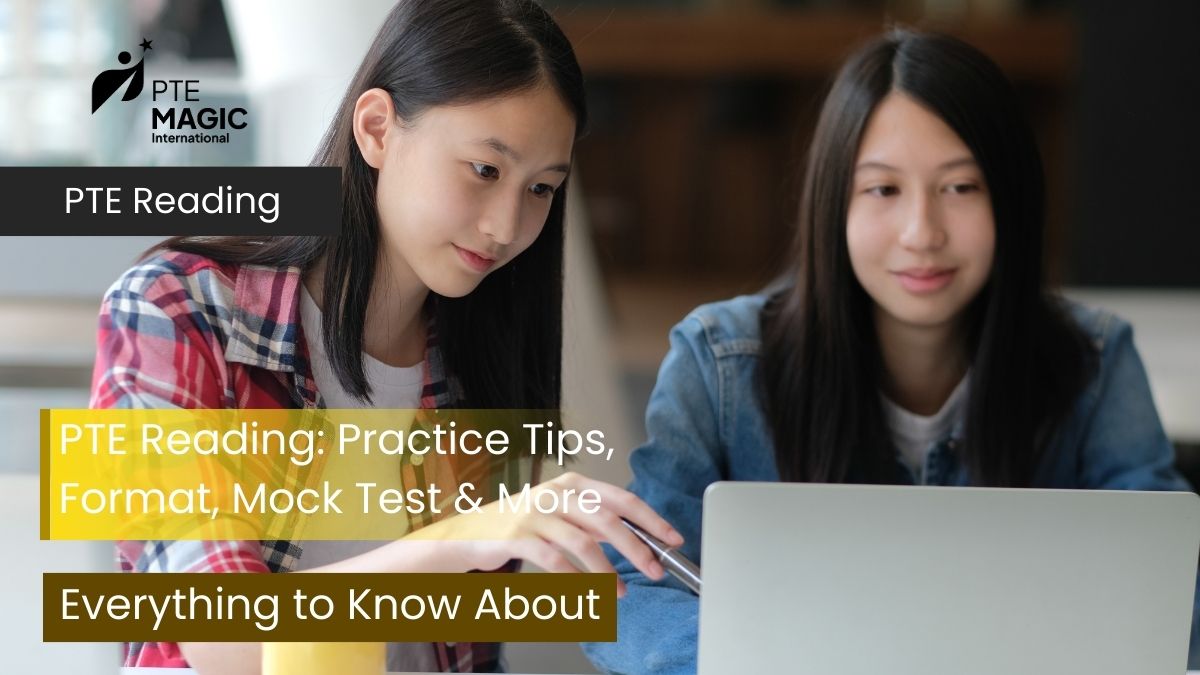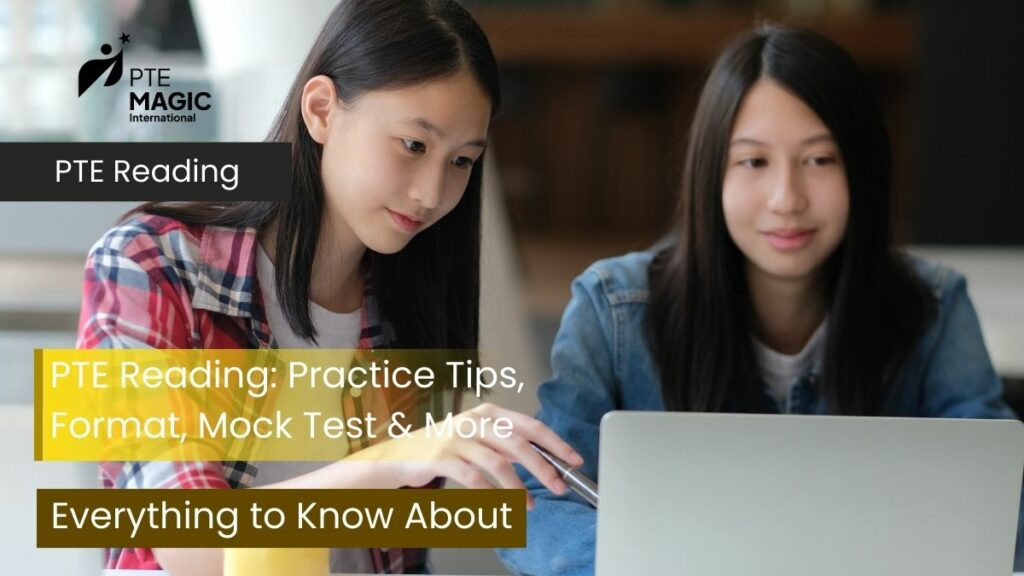No courses in the enrolment list.
PTE Reading is a part of the PTE test. Many people consider it to be an easy one that you should accomplish very well to compensate for the remaining parts.
Therefore, please try your best to gain a high score on this task.
In this blog, PTE Magic will introduce the PTE Reading task, and offer some valuable tips to enhance your reading score.
If you are getting stuck on this task and can not gain your target, let’s scroll down to discover more.
|
How to FINALLY Pass the PTE and Achieve Your Dreams
Stop guessing! Start using proven methods that guarantee results!
✅ Master Every Section: Discover INSIDER SECRETS that secure HIGH SCORES. ✅ Save Time & Effort: Study SMARTER with proven strategies for FAST results. ✅ Real Practice, Real Confidence: Practice with TEST-LIKE questions to feel FULLY PREPARED.
START YOUR PTE SUCCESS JOURNEY TODAY
|
Key Takeaways
- The Reading part will assess your understanding of the content and your skills in extracting key information, identifying details, and making inferences.
- In this task, you will encounter 5 types of questions and must find the most appropriate approach to each.
- You should have a suitable strategy to get a high score on the PTE Reading test. Below are some tips you can apply to improve your score.
Related:
- The only PTE online coaching course you will ever need!
- How to prepare for your next PTE test properly
Overview of the Reading Part in the PTE Test
PTE Reading is the second section of the PTE test. As its name suggests, the Reading part will assess your comprehension skills, gauging not only your understanding of the content but also your skills in extracting key information, identifying details, and making inferences.
In this task, you have 30 to 40 minutes to complete 15 to 20 questions. All the questions will be divided into 5 types of ask (which will be introduced in the next part of this blog). Via them, your reading as well as writing skills can be revealed.
It is not too hard to get a high score in this part, so you should prepare carefully not to lose points regretfully.
The PTE Reading Format

You will encounter 5 types of questions in this task. Each of them has its own characteristics, and you need to understand them to find the most appropriate way to approach them.
PTE Multiple choice single answer
This PTE reading multiple choice single answer section is the first question type you can cope with in the PTE Reading section. In this task, it will provide a short passage and a related question with a list of possible answers. There is only one correct answer in that list. Your task is to read and find out the correct one.
The passage is usually 300 words in length, not too long. You have enough time to complete it well. Therefore, it is better to read the paragraph, the prompt, and the options carefully to find the right answer.
PTE Multiple choice, choose multiple answers
This is the second question you may encounter. In general, it seems quite similar to the first one. However, this PTE multiple choice multiple answer section is more complicated.
You still have a short passage, about 300 words. A list of possible options will be provided as well. You have to choose the right answer from that list. There is more than one correct answer but you will not know the exact number.
With every correct answer, you gain one point. With every wrong option, you lose a point. The minimum score for this task is zero. There are negative marks for this part so you should be careful with your every choice.
You can cope with this question 2-3 times per listening test.
PTE Reorder paragraphs
Moving on to the Reorder Paragraphs task, this segment assesses your understanding of logical organization within a text. It will provide a passage that is divided into several single paragraphs in a “source” box. However, these paragraphs are in jumbled order.
Your task is to organize these source boxes in the right order. To do this, you need to drag and drop it in the right place at the target box.
You will gain one point for every correct pair and get a full score if you arrange it to create a meaningful passage.
This type of question can appear 2-3 times per test.
PTE Fill in the Blanks
Shifting gears to the PTE Reading Fill in the Blanks task, you’ll encounter a passage including about 80 words. But it is not a full passage, it contains some blanks. Your task is to choose the right answer to fill it up.
You can see some words at the bottom corner of the screen. They are missing words that you need to drag and drop them in their right position. There are 3-5 correct answers out of about 8 provided words.
With every correct word, you will gain one point. There are no negative marks for this part so it is better if you don’t leave any blank behind.
You can find them 4-5 times per test so it is quite important with your final score.
PTE Reading and Writing: Fill in the blank
This is the most difficult one in the PTE Listening test. Many test-takers consider it as their nightmare.
In this question, you will see a passage containing about 300 words on the screen. Similar to the Fill in the Blanks, there are some missing words presented by the blanks in this question.
Your task is to find the correct answer from a provided list of words. Click on the drop-down to see possible options to choose from.
With every correct choice, you will achieve one point. There is no negative mark so you can guess the answer in case you are not sure about the correct one.
This question is an important part of the Listening part because of its appearance frequency. You can encounter this question 4-5 times in a test. It is better if you prepare for this part carefully.
Related:
- PTE Reading And Writing Fill In the Blanks tips & tricks
Top 5 tips to improve PTE scores in the Reading section

To get a high score on the PTE Reading test, you should have a suitable strategy. Below are some tips you can apply to improve your score. Hope it helps!
Tip #1: Remember to skim and scan appropriately
Skimming and scanning are two inevitable strategies that you should apply effectively in the Reading test.
Having a good skimming and scanning way to save time can enhance your score significantly.
You should skim when you need to catch up on the overall meaning of the passage or zone of a particular paragraph. It is unnecessary if you spend too much time reading carefully to grasp the general idea of the passage.
When you need to find a particular detail, you should scan the text. It is time to read conscientiously to get the keywords.
Tip #2: Time management
Time management is a crucial factor when you take the PTE Reading test. Different from Listening, in the Reading section, you have about 40 minutes in total to complete the test. You have to allocate time for each question by yourself. So, keep your eye on the clock regularly to control time effectively.
Along with this, you should try to quickly identify the main ideas, and key details, and eliminate irrelevant information while reading to save time.
In case you find a question hard to answer, leave it behind or make a guess briefly then move on. Don’t take too much time on a particular question. You can come back later if you have enough time.
Tip #3: Enhance your vocabulary
Vocabulary plays an important part in making up your final score. To understand the passage, the prompt, and the provided answers, you must get a wide vocabulary range.
You should work on expanding your word bank, focusing on synonyms, antonyms, and context-based understanding to prepare for the test.
There are many ways to widen your vocabulary. You can read something new, watch your favourite movies, and learn new words from it. In this way, you not only get the meaning of the new words but also know their context, and how it to be used. However, these words cannot be so “academic”.
To get closest to the vocabulary range in the test, you can try the sample test and learn new words directly from it.
Tip #4: Practise regularly
Practise always is the best way to conquer a test. The reading test is the same.
Let’s expose yourself to a diverse range of reading materials. PTE passages can cover topics from various fields, including science, technology, arts, and humanities.
You should make yourself familiar with different subjects to enhance your adaptability and ensure you can deal well with all the passage that comes your way.
Mock tests are the ideal choice for you to improve your score. You can access PTE Magic to try such simulation tests. You will approach the latest materials, and effective tips and receive useful feedback.
Applying AI technology allows us to analyze your results in detail. By this, you can know what aspects you need to improve and then take time for it.
Tip #5: Review and learn from mistakes
After each practice session or mock test, thoroughly review your performance. You should identify the patterns in your mistakes and focus on improving those specific areas.
In this way, you can create a personalized study plan that focuses on your weaknesses and gradually improves them.
Conclusion
In conclusion, getting your dream score in the Reading section is not out of reach if you have the right approach method. Hope that the above blog can help you get an overview of this task, and gain some efficient tips to improve your result.
Remember, consistent effort and targeted practice are the pillars of improvement. As you incorporate these tips into your PTE preparation, you’ll find yourself not only boosting your Reading score but also gaining a deeper appreciation for the art of reading in English.
Don’t forget to access PTE Magic to try our practice platform to approach the latest questions and tips to reach your target.
|
How to FINALLY Pass the PTE and Achieve Your Dreams
Stop guessing! Start using proven methods that guarantee results!
✅ Master Every Section: Discover INSIDER SECRETS that secure HIGH SCORES. ✅ Save Time & Effort: Study SMARTER with proven strategies for FAST results. ✅ Real Practice, Real Confidence: Practice with TEST-LIKE questions to feel FULLY PREPARED.
START YOUR PTE SUCCESS JOURNEY TODAY
|
Last updated on 10/03/2025

My name is Moni, and I am a seasoned PTE teacher with over 6 years of experience. I have helped thousands of students overcome their struggles and achieve their desired scores. My passion for teaching and dedication to my student’s success drives me to continually improve my teaching methods and provide the best possible support. Join me on this journey toward PTE success!



























I am a firm believer that the best teachers educate with their hearts not just their minds.
Moni | PTE MAGIC International Founder
Explore PTE
Tips & Tricks
In this task, you are required to read a passage (up to 300 words). After...
Read more →In this PTE Reorder Paragraph task, you will be presented with several text boxes that...
Read more →For this PTE Reading Multiple Choice Multiple Answer task, you must read a short passage...
Read more →